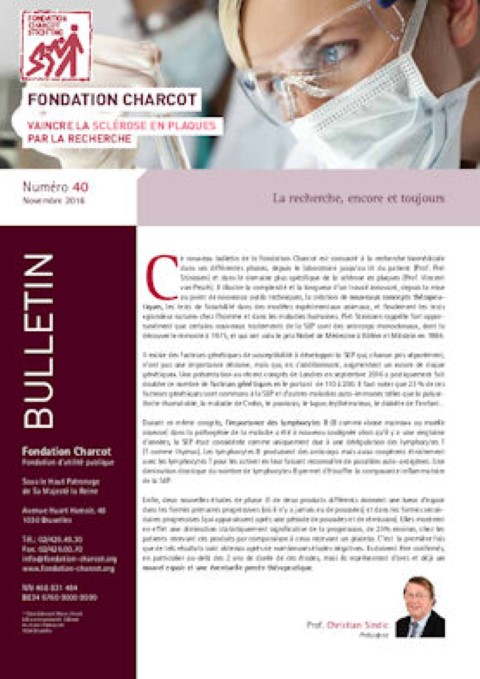This
latest newsletter of the Charcot Foundation is devoted to the various stages of biomedical research, from the laboratory to the patient's bed (Prof Piet Stinissen) and in the more specific field of multiple sclerosis (Prof Vincent van Pesch).
It illustrates the complexity and time it takes to complete innovative work, the development of new technical tools, the creation of new therapeutic concepts, feasibility tests using experimental animal models, and, finally the “full scale” trials on people and human diseases. Piet Stinissen quite rightly reminds us that some new treatments of MS use monoclonal antibodies, whose discovery dates back to 1975, and which earned Köhler and Milstein the Nobel Prize in Medicine.
There are genetic susceptibility factors to developing MS, which each taken separately, are not of decisive importance, but which taken together increase a person’s “genetic risk score". A presentation at the recent London congress in September 2016 almost doubled this number of genetic factors, increasing it from 110 to 200. It should be noted that 23% of these genetic factors are common to MS and other autoimmune diseases such as rheumatoid arthritis, Crohn's disease, psoriasis, lupus erythematosus, childhood diabetes, etc.
The importance of B lymphocytes
At this same congress, the importance of B lymphocytes (B as in Bone marrow) in the pathogenesis of the disease was again stressed although twenty years ago MS was regarded as due solely to a deregulation of the T lymphocytes (T as in Thymus). B lymphocytes produce antibodies but also cooperate closely with the T lymphocytes to activate them by getting them to recognise potential autoantigens. A drastic reduction in the number of B lymphocytes will stifle the inflammatory component of MS.
A hope for the primary progressive forms
Finally, two new Phase 3 studies of two different products give a glimmer of hope for the primary progressive forms (where there have never been flare-ups) and for the secondary progressive forms (that appear after a period of flare-ups and remission). They show a statistically significant reduction in the progression, of around 25 %, in patients receiving these products in relation to those receiving a placebo. This is the first time that such results have been obtained after many negative trials. They need to be confirmed, in particular beyond the 2 years of the duration of these trials, but they already represent new hope and may be a therapeutic breakthrough.
Prof Dr Christian Sindic
Chairman

